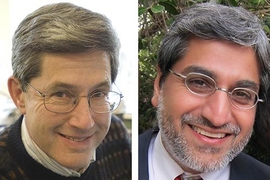How he found a way to work toward a clean energy future, as an electrical engineer, is precisely the insight that MIT professor Rajeev Ram shared with undergraduates, faculty, and graduate students who attended his Feb. 25 talk, as part of a series of undergraduate energy seminars sponsored by the MIT Energy Initiative (MITEI).
MITEI academic coordinator Ann Greaney-Williams says the seminars “help students access information on energy studies and current research, and connect students with career professionals and faculty engaging on energy topics in their classroom and research.” Not only do the seminars bring MIT's energy studies to a large audience, but they also aim, in the long-term, to create an active community, connecting graduate and undergraduate students who care about a clean energy future and can see themselves contributing to change and progress.
Ram is a professor of electrical engineering and the principal investigator for the Physical Optics and Electronics group at the Research Laboratory of Electronics. He was recently named a co-chair of the Energy Education Task Force and the Energy Minor Oversight Committee alongside Bradford Hager, providing institutional leadership for undergraduate and graduate education in energy studies at MIT. In this role, Ram helps guide the development of energy studies at MIT, and encourages students to engage with energy science, technology, and policy.
Ram is eager to dispute a commonly held idea that policy alone — without research or engineering solutions — can solve energy issues. Because he spent three years in Washington working with Congress and the executive branch, Ram is well positioned to challenge this view, though he noteed how difficult it is to change the minds of elected officials. In addition, the number of new laws being passed by Congress is at an all-time low — 165 this past year (compared with 1,028 during the Ford administration) — and the chances of proposed energy legislation being passed are likewise lower than in the past.
Electricity generation is a lead contributor to carbon dioxide (CO2) emissions, and was responsible for 41 percent of total emissions in 2008; this share is expected to grow by another 35 percent by 2035. Ram pointed to the concept of cap-and-trade policy as one example of how to address emissions from electricity generation and other sources: a government sets a limit (cap) on the total amount of greenhouse gases that can be emitted nationally. Companies would then buy or sell the limited permits to emit these gases, primarily CO2. A cap-and-trade bill drafted by then-U.S. Representatives Edward Markey (now a U.S. Senator) and Henry Waxman, the American Clean Energy and Security Act of 2009, passed the House, but due to the predominance of debate around the Affordable Care Act, it never came up for a vote in the Senate.
Rather than being discouraged by this, Ram said that engineers took up the challenge to examine technologies, such as carbon capture, and eventually made an economic case for capture within existing markets. Innovations in carbon capture technology have since brought down prices so that industry has an incentive to invest — at least with oil at $85 per barrel. Ram showed a slide concerning RTI International’s work in this domain, e.g., a sorbent-based CO2 capture process, which is being pilot tested at a cement plant in Norway. “This is an example of an engineering solution stepping into the vacuum created by not having a legislative solution,” Ram remarked. He pointed to and explained a number of technologies that have benefited from advanced research and have been picked up for additional work, such as a chemical looping process, which uses and transforms carbon fuels to pick up CO2.
Using one of his favorite topics — lighting — as an example, he explained how he has found a particularly important place for electrical engineering in the climate change landscape. Electricity generation is evenly divided between commercial, industrial, and residential uses — and 19 percent of commercial and residential electricity use is for lighting. Providing the legislative context, Ram pointed out that a law, the Energy Independence and Security Act (EISA), was passed in 2007. Among its many focuses were biofuels and automobile fuel economy, and it phased out the sale of incandescent lights. Yet its enforcement — after much wrangling — was eventually defunded.
Unfazed, electrical engineers pushed ahead, achieving light-emitting diode (LED) efficiencies and price reductions that made the eventual defunding of EISA inconsequential — and there is much more that can be done. One of Ram’s graduate students discovered a unique aspect of the LED: No matter how small the voltage, some current will flow and it can generate light. What he found was that at low voltages the electrons harvest most of their energy as heat from the environment, not just from the battery. This is an amazing development, said Ram, making it possible to create 110 percent efficient LEDs. This additional source of energy means that the battery is no longer the only supply — hence the electrical-to-optical conversion efficiency can be greater than 100 percent. With discoveries of this kind, electrical engineers are in unique position to double-down on creating small, inexpensive and efficient devices to light the world.
“There is still so much more for us to do in this space,” Ram concluded. Electrical engineering majors can look forward to learning more about power electronics, new materials for power transistors, and magnetic materials for power applications, along with the use of new materials such as silicon carbide and gallium nitride, and wider bandgap semiconductors — all areas of potential research and engagement for students.
MIT Energy Initiative’s next Undergraduate Energy Seminar will be with Kristala Prather, associate professor in the department of chemical engineering. Prather will hold an interactive workshop with undergraduates, “Is it too late (or too early) for biofuels” on Monday, April 25 from 12 to 1:30 p.m. in Room E19-319.







